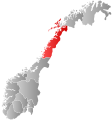Sømna
| Sømna kommune | |||
|---|---|---|---|
| Municipality | |||

View of the village of Berg
|
|||
|
|||
 Sømna within Nordland |
|||
| Coordinates: 65°19′25″N 12°10′38″E / 65.32361°N 12.17722°ECoordinates: 65°19′25″N 12°10′38″E / 65.32361°N 12.17722°E | |||
| Country | Norway | ||
| County | Nordland | ||
| District | Helgeland | ||
| Administrative centre | Vik i Helgeland | ||
| Government | |||
| • Mayor (2007) | Edmund Dahle (Sp) | ||
| Area | |||
| • Total | 194.62 km2 (75.14 sq mi) | ||
| • Land | 191.19 km2 (73.82 sq mi) | ||
| • Water | 3.43 km2 (1.32 sq mi) | ||
| Area rank | 331 in Norway | ||
| Population (2011) | |||
| • Total | 2,025 | ||
| • Rank | 336 in Norway | ||
| • Density | 10.6/km2 (27/sq mi) | ||
| • Change (10 years) | -3.5 % | ||
| Demonym(s) | Sømnværing | ||
| Time zone | CET (UTC+1) | ||
| • Summer (DST) | CEST (UTC+2) | ||
| ISO 3166 code | NO-1812 | ||
| Official language form | Bokmål | ||
| Website | www |
||
|
|
|||
Sømna is a municipality in Nordland county, Norway. It is part of the Helgeland traditional region. The administrative center of Sømna is the village of Vik i Helgeland. Other villages in the municipality include Dalbotn, Sund, Vennesund, and Berg.
The oldest boat remains ever found in Norway (Haugvikbåten - 2,500 years old) was discovered in a bog in Sømna.
Sømna has some of the best agriculture in the region. Dairy and beef cows as well as grains are produced in Sømna. There is also a dairy in Berg that produces milk and cheese.
The municipality of Vik was established on 1 January 1901 when it was separated from the large municipality of Brønnøy. The initial population of Vik was 2,731. In 1941 the municipality was renamed Sømna. On 1 January 1964, Sømna was merged with Brønnøysund, Velfjord, Brønnøy, and part of northern Bindal. Prior to the merger Sømna had 2,347 residents.
This merger was short-lived because on 1 January 1977, all of the old Sømna municipality (except the Hongsetbygda area) was removed from Brønnøy to become a separate municipality once again. There were 2,107 residents in the newly recreated Sømna municipality.
The Old Norse form of the name was probably Søfn. The meaning of the name is unknown, but it is possibly derived from sveifa which means "wind" or "wave" or it could be derived from svefja meaning a "quiet sleep".
The coat-of-arms is from modern times; they were granted on 14 June 1991. The arms show three combined silver leaves of clover (trefoils) on a red background. The arms symbolize agriculture, culture, and prosperity combined.
...
Wikipedia


